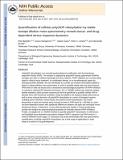Quantification of Cellular Poly(ADP-ribosyl)ation by Stable Isotope Dilution Mass Spectrometry Reveals Tissue- and Drug-Dependent Stress Response Dynamics
Author(s)
Martello, Rita; Mangerich, Aswin; Sass, Sabine; Dedon, Peter C.; Burkle, Alexander
DownloadDedon_Quantification of cellular.pdf (1.547Mb)
PUBLISHER_POLICY
Publisher Policy
Article is made available in accordance with the publisher's policy and may be subject to US copyright law. Please refer to the publisher's site for terms of use.
Terms of use
Metadata
Show full item recordAbstract
Poly(ADP-ribosyl)ation is an essential post-translational modification with the biopolymer poly(ADP-ribose) (PAR). The reaction is catalyzed by poly(ADP-ribose) polymerases (PARPs) and plays key roles in cellular physiology and stress response. PARP inhibitors are currently being tested in clinical cancer treatment, in combination therapy, or as monotherapeutic agents by inducing synthetic lethality. We have developed an accurate and sensitive bioanalytical platform based on isotope dilution mass spectrometry in order to quantify steady-state and stress-induced PAR levels in cells and tissues and to characterize pharmacological properties of PARP inhibitors. In contrast to existing PAR-detection techniques, the LC–MS/MS method uses authentic isotope-labeled standards, which provide unequivocal chemical specificity to quantify cellular PAR in absolute terms with femtomol sensitivity. Using this platform we analyzed steady-state levels as well as stress-induced dynamics of poly(ADP-ribosyl)ation in a series of biological systems including cancer cell lines, mouse tissues, and primary human lymphocytes. Our results demonstrate a rapid and transient stress-induced increase in PAR levels by >100-fold in a dose- and time-dependent manner with significant differences between cell types and individual human lymphocyte donors. Furthermore, ex vivo pharmacodynamic studies in human lymphocytes provide new insight into pharmacological properties of clinically relevant PARP inhibitors. Finally, we adapted the LC–MS/MS method to quantify poly(ADP-ribosyl)ation in solid tissues and identified tissue-dependent associations between PARP1 expression and PAR levels in a series of different mouse organs. In conclusion, this study demonstrates that mass spectrometric quantification of cellular poly(ADP-ribosyl)ation has a wide range of applications in basic research as well as in drug development.
Date issued
2013-04Department
Massachusetts Institute of Technology. Center for Environmental Health Sciences; Massachusetts Institute of Technology. Department of Biological EngineeringJournal
ACS Chemical Biology
Publisher
American Chemical Society (ACS)
Citation
Martello, Rita, Aswin Mangerich, Sabine Sass, Peter C. Dedon, and Alexander Burkle. “Quantification of Cellular Poly(ADP-Ribosyl)ation by Stable Isotope Dilution Mass Spectrometry Reveals Tissue- and Drug-Dependent Stress Response Dynamics.” ACS Chemical Biology 8, no. 7 (July 19, 2013): 1567–1575.
Version: Author's final manuscript
ISSN
1554-8929
1554-8937